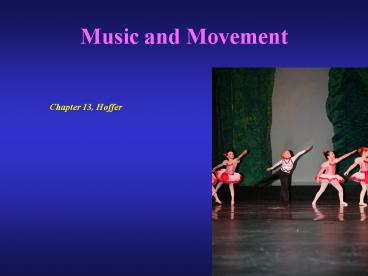Music and Movement - PowerPoint PPT Presentation
1 / 26
Title:
Music and Movement
Description:
... aware of the limitation inherent in the physical settings and plan accordingly. Make a room for movement. ... Make sure to consider the needs of all of your ... – PowerPoint PPT presentation
Number of Views:702
Avg rating:3.0/5.0
Title: Music and Movement
1
Music and Movement
Chapter 13, Hoffer
2
Vini ViniTahitian Welcome SongVini vini vini
vinivana vana vana vanavahini ta-hi-tivini
vini vini vinivana vana vana vanaawe
tu-na-o-te-ah-wey
3
It is the supreme art of the teacher to awaken
joy in creative expression and knowledge.Albert
Einstein
4
Hoffer Chapter 13
- Movement is natural human response to music and
children should be encourage to move to the
musical sounds they hear - Motions is overt, so teachers can easily tell by
the students actions whether they are involved
or not - Helps greatly with behavioral assessments
- Movement can be used as an assessment tool (move
one way for fast, one for slow, etc.) Student can
recognize opposites in music and create
appropriately opposite movements
5
Moving in Structured Situations
- Teachers should be aware of the limitation
inherent in the physical settings and plan
accordingly. - Make a room for movement . Move chairs and desk
to the side of the room, go outdoors in the good
weather, and use gyms, lobbies and hallways.
6
- Explore the possibilities for movement in tight
spaces, in chairs, and at desks. - While allowing the children the freedom to
express musical ideas through movement, set
movement rules that will organized what might
otherwise prove chaotic to the classroom
7
Hoffer Chapter 13
- Structure is the key to successful movement
activities - Have strict rules (dont touch each other,
movements must be exact) If the rule is violated,
the student is to sit out the rest of the
activity
8
Hoffer Chapter 13
- Fingerplays are great activities for younger
students with limited motor skills - Fingerplays are a series of finger, hand, or arm
movements performed rhythmically to depict the
images suggested by a song or rhyme
9
Eency Weency Spider
- The Eency Weency spider climbed up the water
spoutDown came the rain and washed the spider
outOut came the sun and dried up all the
rainAnd the Eency Weency spider climbed up the
spout again
10
(No Transcript)
11
Hoffer Chapter 13
- Action songs are like fingerplays but involve
more than the fingers - Can be any movements appropriate to the music,
either stationary or moving - Individual action is the key to action songs and
what differentiates it from the following
activities
12
(No Transcript)
13
(No Transcript)
14
Hoffer Chapter 13
- Singing games are the next step, which require
group effort and cooperation and coordination - Make sure to consider the needs of all of your
students when implementing singing games
15
(No Transcript)
16
Creative Movement
- Form of dance that is personal, interpretive and
expressive - Can be used to socialize children, provide
entertainment and communicate ideas and feelings
more directly or deeply than words - Lacks authoritarian structure
- There is no one right way of doing things and
there are no specific steps to learn - It is inspired by verbal and musical imagery
17
Dance Concepts
- Nonlocomotor movement- always has one part of the
body anchored to the floor. It is performed in
ones own space without completely transferring
body weight. - Locomotor movement- involves moving around the
wider available area, with the body not anchored
and with complete transfer of weight
18
Nonlocomotor Movement Menu
- Bend Straighten
- Twist Turn
- Swing Rock
- Push Pull
- Curl Stretch
- Rise Fall
19
Locomotor Movement Menu
- Jump Hop
- Leap Gallop
- Walk Run
- Slide Skip
20
Dance Concepts
- The Concept of Time ( speed , Rhythm)
- The Concept of Force ( flow, energy, weight)
- The Concept of Space
- place direction
- size pathway
- level focus (single focus,
multi focus)
21
Pathways
- Straight
- Curved
- Zigzag
22
Moving to Music
23
Moving to Music
24
Hoffer Chapter 13
- Folk and Social Dancing is the final movement
activity - The series books have Dance directions for many
activities - All of the previous rules are heightened,
especially the rules of touching!!! - Remember that dance involves more than the arms
and legs. Get the entire body involved!
25
Suggestions for Teaching Singing Games and Folk
Dances
- Practice a dance before you teach it
- Listen to the entire recording when you prepare a
dance - Play some of the music when introducing a dance
- Show the movements, dont just tell them
- Say direction words like side-back side-touch
- Dance with your students whenever possible. Let
them see that you enjoy dancing, too
26
Excellent Movement References
- Creative Dance for All Ages, Anne Green Gilbert,
(ISBN 0-88314-532-4) - Teaching Movement and Dance, Phyllis Weikart,
High Scope press, ( ISBN 0-929816-03-x) - All of the Sanna Longdens materials, 5 Volumes
of Folk Dance Music for Kids and Teachers. Her
materials are available with a CD and DVD. You
can order from FolkStyle.com, 1-800-894-4378 - Ive Got to Move!, Timothy Brophy, Warner Bros.
Publications (CD included), ISBN 6-5497903496-4) - Move It!, Susie Davies-Spitter and Phil Spitter
( CD included) (ISBN 0-9586663-7-7)
www.welcometomusic.net - Musical Games, Fingerplays and Rhythmic
Activities for Early Childhood, Marian Wirth,
Verna Stassevitch, Rita Shtowell, Patricia
Stemmler, Parker Publishing Company ( ISBN
0-13-607085-x)

